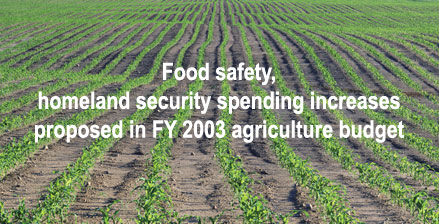Food safety, homeland security spending increases proposed in FY 2003 agriculture budget
Details of the Bush administration's proposed fiscal year 2003 Department of Agriculture budget were released in February. The president's $74.4 billion budget calls for spending increases in such areas as homeland security and record level funding for meat inspection programs. "The president's budget underscores the importance of spending in key areas significant to agriculture," Agriculture Secretary Ann Veneman said. The budget proposes a $146 million increase for programs to protect the nation's food supply from animal and plant pests and diseases, strengthen food safety programs, and support specific research activities. In his State of the Union address, President Bush stressed the need for more homeland security protections. "This budget builds on our efforts to protect agriculture and the food supply from intentional and unintentional risks," Veneman said. "This increase, along with $328 million in supplemental funds provided in the 2002 defense appropriations act, provides needed resources for more border inspectors at ports of entry, increased security at our laboratories, and new research into emerging diseases that threaten crops, livestock, and our food supply." The fiscal 2003 budget calls for $74.4 billion in spending, an increase of $11 billion over the fiscal 2002 budget submitted by the president last year, and $6 billion above actual budget outlays in fiscal 2001. The 2002 budget is estimated to reach $76.6 billion for reasons related to the slowed economy, homeland security, and other unpredictable events such as forest fires. Additional highlights of the FY 2003 USDA budget include:
The proposed budget, Veneman said, reduces funding in some areas and eliminates earmarked research projects so that peer-reviewed and national priority research work could be increased. | ||
